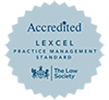
How to Collect Debt From a Sole Trader
Is your business owed money by an individual trading as a sole trader? Are you exploring options to recover that outstanding debt? Then read Thomas Higgins Limited Solicitors’ guide to collecting debt from a sole trader first…
What is a sole trader?
Before we delve into the details of recovering a debt from a sole trader, let’s define exactly what is meant by the term ‘sole trader’.
A sole trader is an individual who is self-employed and the only owner of their business. A sole trader is entitled to all the profits generated by their business (once all relevant tax has been paid).
It’s important to note that a sole trader is also personally responsible for any and all losses incurred by their business.
To set up as a sole trader, individuals need to register with HMRC for ‘self assessment’. As a registered sole trader, an individual is required to keep business records and records of expenses, complete a self assessment tax return every year and pay income tax on their profits. They will also have to pay Class 2 or Class 4 National Insurance contributions.
So, what happens if a sole trader becomes indebted to a business like yours? As the terms of being a sole trader dictate, the sole trader becomes personally liable for the outstanding debt. Should the sole trader not pay their creditor(s), then both their business and personal assets could be at risk.
Is recovering debt from a sole trader the same as recovering debt from a company?
In many ways, recovering debt from a sole trader is similar to recovering debt from a company.
However, there are two important pieces of legislation which you need to be aware of that apply in the case of sole traders:
- Pre-Action Protocol for Debt Claims (PAPDC).
- Breathing Space Regulations.
The Pre-Action Protocol for Debt Claims (PAPDC) was introduced in 2017 and is designed to increase the amount of information that is shared between creditors and debtors.
The PAPDC also aims to help involved parties to resolve a dispute without resorting to court proceedings. In addition, the PAPDC aims to ensure that any court proceedings that do go ahead, do so efficiently.
The Ministry of Justice sets out the aims of the PAPDC as follows:
- Encourage early engagement and communication between the parties, including early exchange of sufficient information about the matter to help clarify whether there are any issues in dispute.
- Enable the parties to resolve the matter without the need to start court proceedings, including agreeing a reasonable repayment plan or considering using an Alternative Dispute Resolution (ADR) procedure.
- Encourage the parties to act in a reasonable and proportionate manner in all dealings with one another (for example, avoiding running up costs which do not bear a reasonable relationship to the sums in issue).
- Support the efficient management of proceedings that cannot be avoided.
Think of the PAPDC as being a set of guidelines that shape the way in which you interact with a debtor during the course of the debt recovery process.
Breathing Space Regulations
Another set of regulations that you should be aware of when attempting to recover debt from a sole trader are the ‘Breathing Space Regulations’.
The Debt Respite Scheme (Breathing Space Moratorium and Mental Health Crisis Moratorium) (England and Wales) Regulations were introduced in 2021 and are designed to assist both individuals and sole traders with problem debt.
The Regulations allow sole traders (who are not VAT registered) to put a pause on debt collection activity against them for at least 60 days - providing them with ‘breathing space’.
It’s important to note that there are two different types of breathing space available to sole traders. These are:
- A standard breathing space - this is available to any non-VAT registered sole trader (however, you must seek debt advice before applying for a standard breathing space). When actioned, a standard breathing space will pause more enforcement action and will freeze most interest and charges on the debt for 60 days.
- A mental health crisis breathing space - this is only available to individuals who are receiving mental health crisis treatment. A mental health crisis breathing space will last as long as the individual is receiving mental health treatment (plus 30 days after the end of their treatment).
These two pieces of legislation mark the biggest differences when it comes to collecting debt from a sole trader compared to a limited company.
How to collect debt from a sole trader
Now that we’ve defined what is meant by the term ‘sole trader’ and some of the debt-related regulations that apply to them, let’s take a look at the most effective ways of recovering debt from them.
Standard debt recovery methods
The first stage of recovering debt from a sole trader should involve exploring all the standard debt recovery methods.
In other words, you should have sent the sole trader an invoice, and followed this up with reminder emails, letters or phone calls.
You must be able to demonstrate that you have taken reasonable steps to recover the money owed using standard means.
Mediation
Another potential option for recovering debt from a sole trader is to engage in mediation.
This involves using the services of a mediator (an impartial person who is trained in conflict resolution) to act as a ‘referee’ in the dispute.
It is the aim of mediation to allow both the debtor and creditor to come to an amicable agreement regarding the settlement of the debt.
Send a pre-action protocol letter
Should the standard means of debt recovery prove fruitless, then the next step is to send a pre-action protocol letter.
A pre-action protocol letter is a formal letter that announces the creditor’s intention to begin legal action should the debtor not pay the outstanding debt.
Pre-action protocol letters are typically sent in a hard copy format and should ideally have been written by a specialist debt collection solicitor.
When sending a pre-action protocol letter to a sole trader, there are a number of specific things that the letter should contain. These are:
- The name and address of the creditor.
- The name and address of the debtor.
- The date the letter was issued.
- The total amount of money owed.
- A reasonable time limit for the debtor to reply (typically 30 days).
- A clear statement that legal action will be taken should the debt not be settled.
In order to satisfy the requirements of the Pre-Action Protocol for Debt Claims, your letter should also include:
- An information sheet that includes the contact details of organisations that offer free, impartial and non-judgemental debt advice.
- A reply form (known as an Annex 1 Information Sheet).
- A financial statement that the debtor should complete and return. This financial statement is known as Annex 2 Standard Financial Statement.
In the case of sole traders, it is normally the case that they are given 30 days to respond to the pre-action protocol letter and reply via the Annex 1 Information Sheet.
The next steps
In the best cases, the debtor will reply to the pre-action protocol letter within the specified time frame.
How they reply will determine your next steps:
- If the debtor responds stating that they are seeking debt advice, you (the creditor) must allow a reasonable period of time for the advice to be obtained.
- If the debtor responds in the reply form that they require time to pay the debt then you (the creditor) and the debtor should try to come to an agreement for the debt to be paid in instalments. These instalments should be proportionate to the debtor’s income and expenditure. If you (the creditor) do not wish to offer a payment plan, then you must explain in writing to the debtor your reasons.
- If you receive only a partially-completed reply form, then you should attempt to contact the debtor to obtain any further information you require to understand the debtor’s position.
Should the sole trader not respond to your pre-action protocol letter within the 30-day time period, then you will be able to begin court action.
How to send a pre-action protocol letter to a sole trader
If you have determined that the best course of action is to send a pre-action protocol letter to a sole trader that owes you money, then it’s important that you go about it the correct way.
As we mentioned earlier, it’s highly recommended that you instruct a suitably qualified and experienced debt collection solicitor to write and issue the pre-action protocol letter.
It’s vital that pre-action protocol letters are written and issued in the correct way. This is because any mistakes made at this stage can undermine your claim in court.
Plus, given the highly affordable cost of pre-action protocol letters it makes financial sense to appoint a solicitor to issue the letter on your behalf.
Reclaim sole trader debt with Thomas Higgins Limited Solicitors
If you’re attempting to reclaim outstanding debt from a sole trader, then choose Thomas Higgins Limited Solicitors.
We are able to issue pre-action protocol letters at highly affordable rates and have a strong track record of success.
What’s more, once you open an account with us, you can instruct us online, access your existing cases, read copies of correspondence we have received and any letters we have sent on your behalf.
Login to your account with Thomas Higgins Limited Solicitors now




